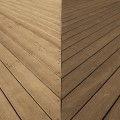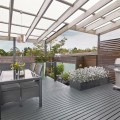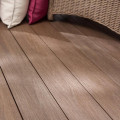Different Types of Composite Decking: Hollow vs Solid Core Boards
Once you decide to use composite decking material for your home’s or business’s deck, you must then decide whether you want to go with solid or hollow boards. Both options produce an attractive and functional deck, so base your decision on your requirements and personal preferences.
Solid boards, as the name suggests, are made of solid material, while hollow boards (also called engineered boards) feature ribbed centers. Each provides a durable, easy-to-maintain decking material, so which is best for your project?
Solid Boards Resemble Real Wood
Some homeowners prefer solid boards because they look more like the real lumber traditionally used for decking. Their deck board ends are more authentic looking because they don’t feature the tunnel-like design of hollow boards. Composite decking contains real wood (as well as plastic), but if you want your deck to look like it’s made of solid wood, you might prefer solid composite boards.
On the other hand, while hollow boards can look more manufactured, they can look more uniform. They don’t feature as many of the grain variations as do the solid boards, so if you prefer uniformity, hollow boards might work best for your deck. Also, finishing strips or fascia boards are available for hollow boards to overcome the visual aspect of the deck board ends.
Hollow Boards Weigh Less
Building your own deck is a labor-intensive process. If you want to work with lighter-weight materials, you could benefit from hollow boards, which weigh considerably less than their solid counterparts. You might have an easier time transporting and positioning the boards, as well.
If you prefer solid boards, reduce your workload by soliciting a friend or relative to help with the project. Use gloves to protect your hands while working with heavy materials, and take frequent breaks to give your muscles a rest. Alternatively, hire a professional to build the deck for you if you have any doubts.
Solid Boards Enhance Durability
Both solid and hollow boards are sufficiently strong enough to handle considerable weight. However, solid boards, because of their denser construction, are particularly strong. If you plan to load down your deck with heavy objects, such as hot tubs, grills, and furniture, solid boards might offer the most stability.
Of course, other factors influence any deck structure’s durability. The strength of the joists, the quality of the materials, and the fasteners you use to put the structure together also play a part in determining its ability to withstand weight and the elements.
Hollow Boards Respond Less to the Elements
In some areas, extreme temperature and moisture fluctuations can cause solid boards to expand or contract over time. This loosens the fasteners and sometimes causes warping. Hollow boards are less impervious to these changes, which increases their lifespan.
For example, if you live in a beach town or a city that experiences extreme cold and hot temperatures, you might opt for hollow boards. Don’t forget, however, that deck maintenance also impacts the longevity and quality of any decking material. Follow the manufacturer’s instructions to protect your composite deck from environmental wear and tear.
The differences between hollow and solid composite boards lie primarily in perception and preference. Both will provide you with a strong and stable deck that lasts. As with any home improvement purchase, educate yourself on the details, and select the material that works best for you.
What type of decking are you considering for your project?







